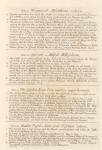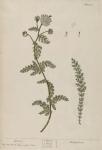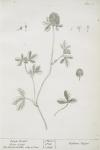

 17. Wormwood. Absinthium vulgare.
17. Wormwood. Absinthium vulgare.
Also see #017, Wormwood - #116, Tarragon
1. It grows to be three Foot high; the Stalks are hoary, full of a white Pith, ye Leaves are a Willow-green above, & a light hoary underneath; the Flowers are yellow.
2. It grows in Lanes and waste Places, and flowers in Iuly and August.
3. The Leaves & Tops are used; they purge Melancholy Humours, provoke Urine, restore an Appetite that is lost by Drinking. They are good against the Disorders of ye Stomach, vomiting & Surfeits; they strengthen the Viscera, kill Worms, & are of service in Dropsies, Jaundice, tertian & quartan Agues. In all ye above Cases it is infused in Water, Ale or Wine. A Cataplasm of the green Leaves beat up with Hog's Lard was commended to Mr. Ray by Dr. Hulse as a good external remedy against ye swelling of the Tonsils & Quinzy. See Rays Cat. Plantarum. Officinal Preparations are, a simple Water; a greater and a lesser compound Water; a simple and a compound Syrup; an Oil by Infusion, and decoction; and Oil by Distillation; an Extract; a fixt Salt.
4. Greek, Αψίνδιον. Latin, Absinthium vulgare or Ponticum. Spanish, Assentios or Alosna. Italian, Assenzo or Assentia. French, Aluyne or Absince. German, Wermut. Dutch, Alsem.

 18. Yarrow or Milfoil. Millefolium.
18. Yarrow or Milfoil. Millefolium.
1. The Stalks grow about eighteen Inches high, and are somewhat hairy; the Flowers are white, and grow on the Tops of the Branches in flat Umbels.
2. It grows in most Fields, and flowers in Iune and Iuly.
3. The Leaves are esteemed cooling, drying, binding, serviceable in all kinds of Haemorrhages; as spitting or vomiting Blood, bleeding at the Nose, Dysentery, the too great Flux of the Menses, violent flooding, cooling and tempering its immoderate Sharpness; it is good in a Gonorrhea, Strangury, Heat of Urine; when applied outwardly it is of Service against Ruptures & staunches ye bleeding of Fresh Wounds.
4. Greek, Στρατιώτης χιλιόφυλλος μέγας. Latin. Millefolium terrestre vulgare, or vulgare Flore albo. Spanish. Millhogas yerva. Italian. Millefoglio. French, Millefueille. German. Garben. Dutch. Duysiud-blad.

 19. The Garden Bean. Faba major, or major hortensis.
19. The Garden Bean. Faba major, or major hortensis.
Also see #019. The Garden Bean - #208. The True Orobus
1. The Garden Bean grows to be three or four Foot high; the Leaves are a pale Green, and the Flowers white, with two black Spots in them.
2. It is sown in Gardens, and flowers in May, and the Beans are ripe in Iune or Iuly.
3. The Water distilled from ye Flowers is used by many as a Cosmetic; & that from the Pods is accounted good for ye Wind & Gripes in Children. Dioscorides says, ye Meal made into a Cataplasm removes ye Swellings in Women's Breasts which are occasioned by the Milk; he also recommends it mixt with Roses, Time, & ye white of an Egg, as good for purging all watery Rheums from ye Eyes; & mixed with Wine as good for ye Web & blood-shot of the Eyes. The Meal given inwardly is esteemed good for a bloody-flux. The officinal Preparations are, the Aqua Florum et Siliquarum Fabarum.
4. Greek, Κύαμος. Latin, Faba major, or Faba major hortensis. Spanish, Havas. Italian, Fava. French, Fave. German, Bonen. Dutch, Roomse, or Bocre-Boonen.
 20. Meadow Trefoil or Clover Grass. Trifolium vulgare.
20. Meadow Trefoil or Clover Grass. Trifolium vulgare.
1. The Leaves are a pale Green, and the Flowers purple spotted with white, the Stalks grow to be eighteen Inches high.
2. It grows in most Fields and Meadows, and flowers in May or Iune.
3. The Leaves & Flowers are used as drying, binding, good for all kind of Fluxes ye Strangury & heat of Urine; made into a Cataplasm with Hog's Lard they are reckoned good for Tumours & Inflammations. Matthiolus says a Decoction of ye Whole Plant in Flowers, stops ye Whites in Women.
4. Greek, Τρίφυλλον. Latin, Trifolium vulgare. Spanish, . Italian, Trifoglio. French, Troisfueille. German, Biesenclee. Dutch, roode Klaaveren.

